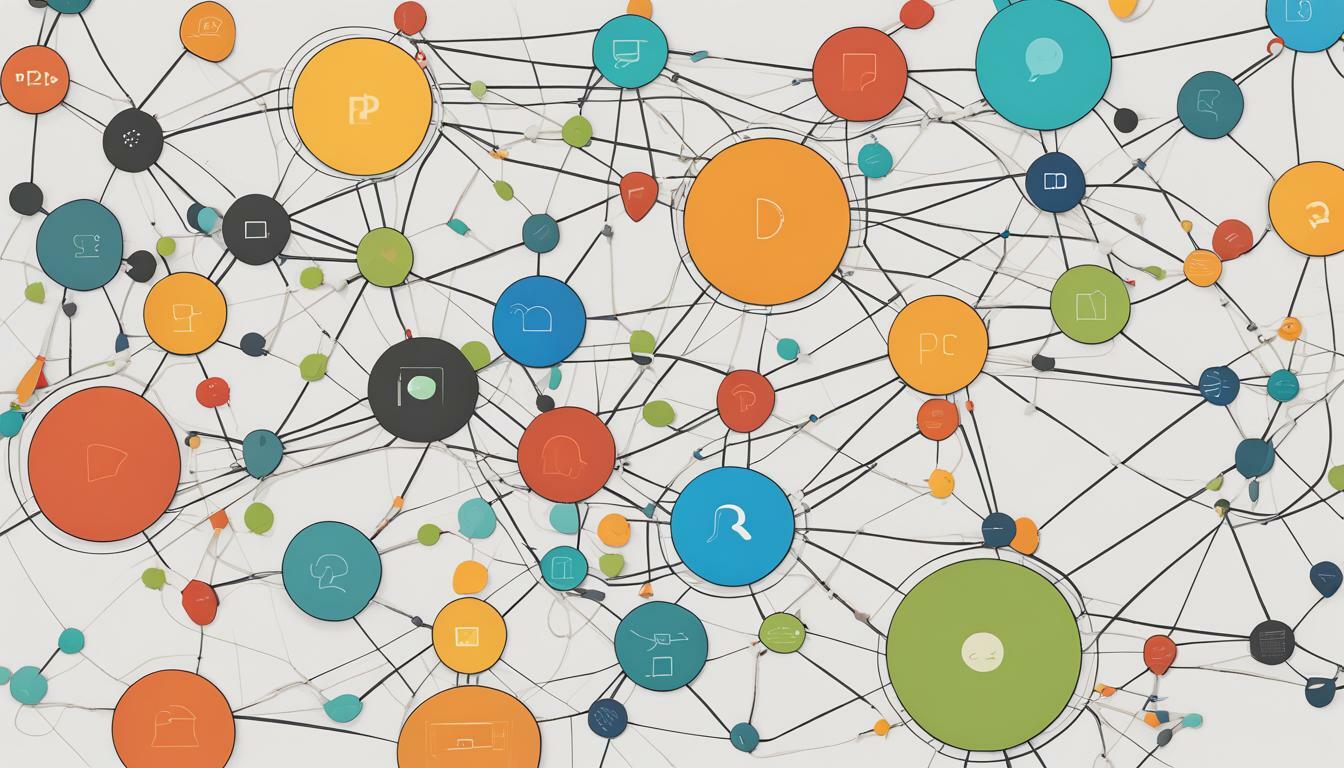
Peer-to-Peer (P2P) technology has been around for decades, but it has gained prominence in recent years due to its decentralized nature and ability to facilitate direct communication between parties. Simply put, P2P networks allow computers, or nodes, to communicate with one another without the need for a central server. This article provides a simplified guide to help you understand the basics of P2P technology, its various applications, and its impact on the digital world.
Key Takeaways
- P2P technology allows direct communication between nodes, without the need for a centralized server.
- P2P networks are decentralized, meaning that there is no single point of failure.
- P2P technology has numerous applications, from file sharing to lending and payments.
What is Peer-to-Peer (P2P) Networking?
Peer-to-Peer (P2P) networking refers to a type of network architecture in which participants share resources directly with each other without the need for a centralized server. P2P technology allows computers and devices to connect and interact with each other on an equal basis, creating a decentralized network that can be used for various purposes.
One of the key advantages of a P2P network is its resilience and scalability. Since there is no single point of failure, P2P networks can continue to function even if some nodes go offline or are compromised. This makes them well-suited for applications that require high availability and robustness.
P2P networking can be used for a variety of purposes, including file sharing, communication, and financial transactions. By leveraging P2P technology, participants can take advantage of the benefits of decentralization, such as increased privacy, control, and security.
Advantages of P2P Technology
There are several advantages of P2P technology, including:
- Decentralization: P2P networks are decentralized, meaning that there is no central authority controlling the network. This can increase privacy, security, and control over data, as participants can directly interact with each other without relying on intermediaries.
- Resilience: P2P networks are resilient, meaning that they can continue to function even if some nodes go offline or are compromised. This makes them well-suited for applications that require high availability and robustness.
- Scalability: P2P networks can be highly scalable, meaning that they can handle large numbers of participants and data without requiring significant infrastructure investments.
How P2P Networking Works
P2P networking works by allowing individual participants to connect and communicate with each other directly. When a participant joins a P2P network, they become a node that can send and receive data from other nodes in the network.
One of the key features of P2P networking is its use of peer-to-peer protocols, such as BitTorrent and Gnutella. These protocols allow participants to discover and interact with each other on a global scale, creating a distributed network that can be used for various applications.
In a P2P network, data is typically distributed across multiple nodes, making it difficult for any single node to censor or control access to the data. This can increase privacy and security, as participants can access data without relying on centralized servers or intermediaries.
Overall, P2P networking is a powerful technology that can be used for a variety of purposes. By leveraging P2P technology, participants can take advantage of the benefits of decentralization, such as increased privacy, control, and security.
Peer-to-Peer Communication: How Does it Work?
Peer-to-Peer communication is a type of decentralized communication where information is exchanged directly between peers without the need for a central server. This means that each participant in the communication network acts as both a client and server, facilitating direct communication between devices.
One of the key components of Peer-to-Peer communication is the P2P protocol, which enables direct communication between peers. The protocol works by dividing data into small chunks, which are then sent between peers using a combination of peer discovery, routing, and data transfer techniques. This allows for faster data exchange and improved network efficiency.
Unlike traditional client-server networks, where all communication flows through a single server, Peer-to-Peer communication allows for more efficient and secure communication. This is because if one peer fails or goes offline, communication can still occur between other peers in the network. This decentralized nature also makes it more difficult for a single point of failure or malicious attack to bring down the entire network.
One of the most popular applications of Peer-to-Peer communication is file sharing. This involves the direct exchange of files between peers, without the need for a central server. P2P file sharing has revolutionized the way large files are shared, making it faster and more efficient than traditional methods. It has also led to the rise of popular file-sharing platforms such as BitTorrent.
In conclusion, Peer-to-Peer communication is a decentralized communication model that enables direct and efficient exchange of information between peers. The P2P protocol plays a crucial role in enabling this communication, allowing for faster and more secure data transfer. P2P communication has numerous applications, including file sharing, and is an important part of the evolving technology landscape.
P2P File Sharing: A Revolution in Data Exchange
Peer-to-Peer (P2P) file sharing is a decentralized method of distributing digital files, allowing users to share and download files directly from one another, without the need for a central server. It has transformed the way we share data, enabling users to share large files quickly and easily.
One of the biggest advantages of P2P file sharing is its ability to handle large file sizes. Traditional file-sharing methods, such as email and FTP, have file size limits that can make it difficult to share large files. With P2P file sharing, files are broken down into smaller pieces and shared between peers, allowing for quick and efficient downloading.
P2P file sharing has also given rise to a number of popular file-sharing platforms, such as BitTorrent and eDonkey. These platforms allow users to search for and share files with others on the same P2P network, creating a vast library of shared files.
However, P2P file sharing has also faced its fair share of challenges and controversies. One of the main concerns has been the illegal sharing of copyrighted material, such as movies and music. This has led to legal battles and the shutdown of several P2P file-sharing platforms.
Despite these challenges, P2P file sharing continues to be a popular and effective method of sharing data. It offers a decentralized and efficient way to move large files, without relying on a central server. As technology continues to evolve, we can expect to see further advancements in P2P file sharing and its impact on data exchange.
P2P Lending: Empowering Borrowers and Investors
Peer-to-Peer (P2P) lending has revolutionized the lending industry, offering borrowers an alternative source of funding and providing an opportunity for investors to earn higher returns on their investments.
Through P2P lending platforms, borrowers can connect directly with individual investors, bypassing traditional financial institutions. This allows for a more personalized and flexible lending process, as borrowers can often access funds more quickly and at lower interest rates than they would through traditional lenders.
For investors, P2P lending provides an opportunity to diversify their portfolio and earn higher returns than they would through traditional savings accounts or other investment options. P2P lending platforms often offer a range of risk levels and investment options, allowing investors to tailor their portfolios to their specific needs.
Some popular P2P lending platforms include LendingClub, Prosper, and Funding Circle. Each platform offers its own unique features and benefits, with some focusing on specific types of loans or investment opportunities.
While P2P lending has many advantages, it is important to carefully consider the risks involved before investing or borrowing. As with any investment, there is always the potential for loss, and borrowers should be aware of the terms and fees associated with P2P loans.
Overall, P2P lending has opened up new opportunities for both borrowers and investors, creating a more accessible and convenient lending process.
P2P Marketplace: Connecting Buyers and Sellers Directly
In recent years, Peer-to-Peer (P2P) marketplaces have been growing rapidly, revolutionizing the way people buy and sell goods and services. P2P marketplaces offer a platform where individuals can connect directly with other individuals to buy or sell a wide range of products or services. These marketplaces have disrupted traditional retail models, providing consumers with more choices and often at lower prices.
P2P marketplaces utilize the power of technology to eliminate intermediaries, such as retailers and wholesalers, allowing buyers and sellers to transact directly. This approach has several benefits, including lower transaction costs, increased transparency, and greater control over the buying and selling process.
One of the most significant advantages of P2P marketplaces is their ability to facilitate a more personalized and localized shopping experience. They allow people to find unique items that may not be available through traditional retailers and often enable buyers to negotiate directly with sellers to reach a mutually agreeable price. Additionally, P2P marketplaces can provide sellers with a platform to monetize underutilized assets, such as unused parking spaces or spare rooms in their homes.
Some popular P2P marketplaces include Etsy, eBay, and Craigslist. These platforms have each carved out a unique niche, serving different types of buyers and sellers with varying needs and interests. For example, Etsy is known for its focus on handmade and vintage items, while eBay is a more general marketplace for a wide range of goods.
However, as with any technological innovation, there are potential drawbacks to P2P marketplaces. Fraudulent activity is a concern, as scammers can take advantage of the lack of regulation in these markets. Additionally, some P2P marketplaces may have limited liability protection, leaving buyers and sellers vulnerable if something goes wrong during a transaction.
Despite the potential risks, P2P marketplaces are here to stay, and their impact on the retail industry is only likely to grow. As consumers continue to demand more personalized and localized shopping experiences, P2P marketplaces will play an increasingly important role in connecting buyers and sellers directly.
P2P Payments: Simplifying Financial Transactions
Peer-to-Peer (P2P) payments are changing the way people transfer money. Instead of relying on traditional banking systems, P2P payments allow individuals to transfer money directly to each other using a P2P platform. This means that you can send money to your friend or family member without the need for a middleman.
P2P payments are convenient and quick. Transactions can be completed within minutes, and the recipient can access the funds immediately. These payments are also secure, as they use encryption to protect your personal and financial information.
One of the main advantages of P2P payments is that they are often free or charge very low fees. This makes them a more affordable option than traditional wire transfers or other payment methods.
P2P payments can be made using a variety of methods, including mobile apps, online platforms, and even social media platforms. This makes them accessible to a wide range of users, regardless of their technical knowledge.
As P2P payments continue to gain popularity, more and more P2P platforms are emerging. These platforms offer a range of features and benefits, such as rewards programs and instant transfers, making them even more attractive to users.
Overall, P2P payments are simplifying financial transactions and providing a more convenient and cost-effective way to transfer money. As the technology continues to evolve, it is likely that we will see even more innovations in the P2P payment space.
Exploring P2P Platforms: A Diverse Ecosystem
Peer-to-Peer (P2P) technology has given rise to a diverse ecosystem of platforms that connect individuals for various purposes. From file-sharing to lending and payments, P2P platforms offer decentralized solutions that promote faster, cheaper, and more efficient transactions. Here is an overview of different types of P2P platforms:
| P2P File Sharing Platforms | P2P Lending Platforms |
|---|---|
| P2P file sharing platforms allow users to share files directly with other users without the need for a central server. Popular examples of P2P file sharing platforms include BitTorrent and eMule. | P2P lending platforms enable borrowers to obtain loans directly from investors, cutting out traditional financial intermediaries. Examples of P2P lending platforms include LendingClub and Prosper. |
| P2P Marketplaces | P2P Payment Platforms |
|---|---|
| P2P marketplaces connect buyers and sellers directly, allowing them to transact without the need for intermediaries like eBay or Amazon. Popular examples of P2P marketplaces include Craigslist and Etsy. | P2P payment platforms enable users to send and receive money directly, without the need for banks or other financial institutions. Examples of P2P payment platforms include Venmo and PayPal. |
Each type of P2P platform offers unique benefits and has its own set of challenges. However, they all share a common goal of empowering individuals and promoting greater financial freedom. As P2P technology continues to evolve, we can expect to see even more innovative solutions emerge that revolutionize the way we exchange goods and services.
The Pros and Cons of Peer-to-Peer (P2P)
Peer-to-Peer (P2P) technology offers many advantages, particularly in terms of decentralization and direct communication. However, there are also potential downsides to consider.
Pros:
- P2P network: Decentralized networks eliminate the need for a central server, reducing the risk of downtime and enabling faster data transfer.
- P2P technology: Direct communication between peers enables faster and more secure file sharing and financial transactions.
- P2P lending: Borrowers have access to more affordable loans, while investors can benefit from higher returns.
- P2P file sharing: Users can share large files quickly and efficiently, without the need for costly servers or cloud storage.
- P2P marketplace: Direct connections between buyers and sellers can lead to lower prices and greater variety of goods and services.
- P2P payments: P2P payments simplify transactions between individuals, allowing for faster and more convenient exchanges.
- P2P protocol: The use of P2P protocols can reduce the risk of attacks and protect user privacy.
Cons:
- P2P network: Without a central server, P2P networks can be more vulnerable to hacking and malicious attacks.
- P2P technology: The direct connection between peers can also make it easier for viruses and malware to spread.
- P2P lending: There is always the risk of default, and investors may not receive their expected returns.
- P2P file sharing: The sharing of copyrighted material can lead to legal consequences.
- P2P marketplace: Lack of regulation can make it harder to ensure the quality and safety of goods and services.
- P2P payments: Fraudulent transactions can occur if proper security measures are not in place.
- P2P protocol: While P2P protocols can increase security, they can also be more complex and difficult to navigate.
Despite these potential drawbacks, Peer-to-Peer (P2P) technology has proven to be a game-changer in many industries, offering faster, more efficient, and more affordable solutions. As long as users are aware of the potential risks and take appropriate precautions, the benefits of P2P technology can outweigh the cons.
Conclusion
Peer-to-Peer (P2P) technology has revolutionized a multitude of industries, from file sharing to lending and payments. The decentralized nature of P2P networks offers numerous benefits, including greater security, efficiency, and accessibility.
However, as with any technology, P2P does have its drawbacks. Security concerns are a primary consideration, as P2P networks are vulnerable to malicious attacks. Additionally, the lack of regulation in some P2P applications has led to legal challenges and controversies.
Despite these challenges, the potential for P2P technology is enormous. As the P2P ecosystem continues to evolve and expand, we can expect to see even more innovative applications and advancements in this exciting field.
FAQ
Q: What is Peer-to-Peer (P2P) technology?
A: Peer-to-Peer (P2P) technology is a decentralized network architecture where computers, called peers, communicate directly with each other without the need for a central server. This allows for efficient sharing of resources and information.
Q: How does P2P networking work?
A: P2P networking works by connecting peers directly, enabling them to share files and resources. Each peer acts as both a client and a server, allowing for the distribution of data across the network. This decentralized approach offers increased scalability and resilience.
Q: What is Peer-to-Peer communication?
A: Peer-to-Peer communication refers to the direct exchange of information between peers without the involvement of a central server. It allows for real-time communication, file sharing, and collaborative activities, enhancing efficiency and reducing dependency on centralized systems.
Q: How does P2P file sharing revolutionize data exchange?
A: P2P file sharing enables users to share files directly with one another, bypassing the need for a centralized server. This has revolutionized data exchange by allowing for faster, more efficient sharing of large files, and has facilitated the rise of file-sharing platforms.
Q: What is P2P lending?
A: P2P lending is a form of borrowing and lending that takes place directly between individuals through online platforms. It eliminates the need for traditional financial institutions, offering borrowers more accessible loans and providing investors with alternative investment opportunities.
Q: What are P2P marketplaces?
A: P2P marketplaces are platforms that connect buyers and sellers directly, without the involvement of intermediaries. They offer a wide range of products and services, providing individuals with opportunities to buy and sell directly from one another, increasing efficiency and reducing costs.
Q: What are P2P payments?
A: P2P payments are financial transactions made directly between individuals through online platforms. They simplify and expedite the process of sending and receiving money, eliminating the need for traditional payment methods, such as cash or checks.
Q: What types of P2P platforms exist?
A: There are various types of P2P platforms, including file-sharing platforms, lending platforms, payment platforms, and marketplaces. Each type serves a specific purpose, catering to different needs and facilitating direct interactions between individuals.
Q: What are the pros and cons of Peer-to-Peer technology?
A: The advantages of Peer-to-Peer technology include increased efficiency, decentralized control, and greater accessibility. However, there are also potential security concerns and challenges associated with P2P networks, such as the risk of malicious activity and the need for robust security measures.






